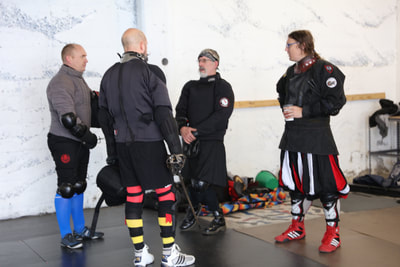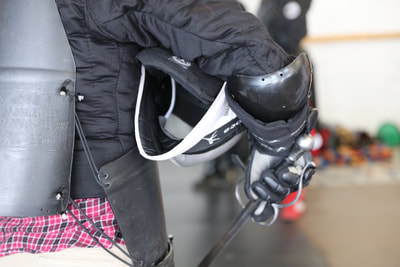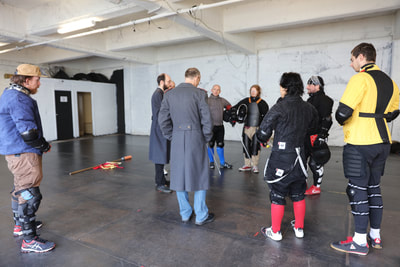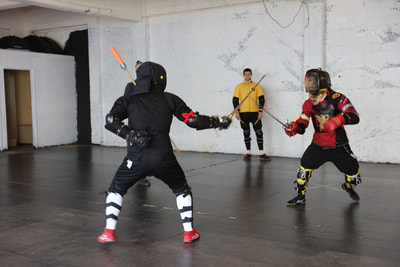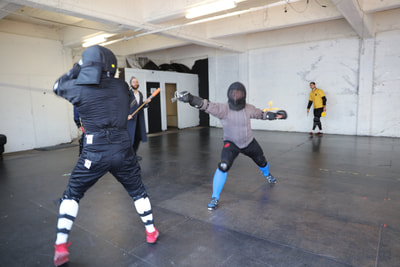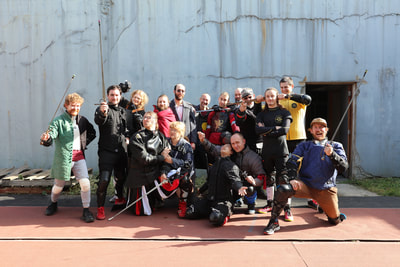We connect you with the top talents, celebrities, organsations and businesses in the world.
Happy reading!
Happy reading!
THE SCHOOL OF HISTORICAL FENCING
website
website
When it comes to fencing what do you see?
Do you see Olympic games and sportsmen fighting in the black masks and strange words yelled out on the arena "touché, touché" What else do you see?
I see good old Europe, Germany or France and fencing musketeers and armed soldiers of the kings and cardinals. This is a different fencing. It is called historical.
I was not planning to attend the tournament myself in the first place but was asked to by one of our media crew members. I was really busy but agreed to attend in order to write about the event properly and to introduce our media crew to Gindy for the future collaborations.
When I arrived to the place... hmmm... I thought: "oh my god, I have to make sure that this is safe" I was not so sure to be honest. It is located at the back of many small industrial storages and commercial buildings seemingly standing without any purpose IMHO. I was shown the way to the Melbourne Salle . The hall was not impressive either. I felt scared that something would not be quite right here.... Little I knew.... We always should keep in mind: the first impression can trick you and the things might appear not the way they really are. The outfits of the tournament participants were very impressive: leather aprons, ancient style gloves, boots, pants and tops. The faces were all covered. The armory was nothing to what I saw ever in my life. The game started and I suddenly was placed inside the film. the game sucked me in with its attractive energy and I could not take my eyes away fro, the scenery: the movements of the judge, the fighters, the people around hem who counted the scores, the toy mammoth (apparently the prize (?)). The fighters changed each other every 10-15 minutes. I was like a bee attracted to the honey - no,this is the wrong metaphor indeed but it sounds right somehow... I could not see anything else: the half destroyed surroundings suddenly disappeared; I was like a teenager in front of the computer in the room that was not cleaned for months but cared... They fought , a couple after the couple. They sweated, they drank water, they moved forward and the refrained. Some won some lost of course but they felt the same I felt and I knew it - they were all bewitched by the energy of the game: so elegant though so powerful. The rapier were the prolongation of their hands - extended iron that could prick, touch and wound the enemy. Nevertheless no matter what I felt - it was all inside my mind - I am sure I was like one of those blind wise men who touched the elephant by the tail and said "The elephant is a rope" : what ever the game of historical fencing appeared to me for its first time had perhaps nothing to do with what was happening inside the fighting men's heads. They all seemed so happy and so excited. I also trust many of them spent one of their best Sundays in this hall. One thing I know for sure: the toy fluffy mammoth found its right home after the final game.
...and we had a good and quiet lunch...
by NM
PS. shall I add something else? Yes please Natasha!
What I learned personally
1. fencing is a cool skill to have. In case you need to fight or just to play it is a very graceful game
2. guys learn to fence in style after years and years of hard work and practice. the skills are seen right through.
3. a knight is not a knight without a good sword
4. no matter what you are dressed in and how you present yourself you are judged only by the end of your fights: winner or looser can be anyone. there is always someone more agile than you, there is always someone who plays it better than you. always.
5. fencing is the Historical European Martial Art
6. the guys fight for real in tournament - there is no messing around
7. do you know that with World War I and historical swords and rapiers fighting for entertainment fell out of favour
8. I still do not understand how can they learn the art that existed since 600 years ago.
9 do you know that Fiore Furlan dei Liberi da Premariacco, a guy who taught people how to duel to the death and was considered the greatest fencing master of the late 1300s
10. the guys who fight might appear as nerds to you from the first sight as everyone plays computer games now but you would be a dumb fool to say that as this art of fighting is so cool and only is opening its heart to the selective people
11. what was missing on Sunday... yes, I see that was coming: dragons of course!
12. the people who are interested in historical fencing are not only cool, they are intelligent and very weird.
13. the fighter are very fit as it is not a computer game after all
14. i am sure the fighters all have licence to carry the weapons as the swords seem dangerous to me, their swords are real!
Do you see Olympic games and sportsmen fighting in the black masks and strange words yelled out on the arena "touché, touché" What else do you see?
I see good old Europe, Germany or France and fencing musketeers and armed soldiers of the kings and cardinals. This is a different fencing. It is called historical.
I was not planning to attend the tournament myself in the first place but was asked to by one of our media crew members. I was really busy but agreed to attend in order to write about the event properly and to introduce our media crew to Gindy for the future collaborations.
When I arrived to the place... hmmm... I thought: "oh my god, I have to make sure that this is safe" I was not so sure to be honest. It is located at the back of many small industrial storages and commercial buildings seemingly standing without any purpose IMHO. I was shown the way to the Melbourne Salle . The hall was not impressive either. I felt scared that something would not be quite right here.... Little I knew.... We always should keep in mind: the first impression can trick you and the things might appear not the way they really are. The outfits of the tournament participants were very impressive: leather aprons, ancient style gloves, boots, pants and tops. The faces were all covered. The armory was nothing to what I saw ever in my life. The game started and I suddenly was placed inside the film. the game sucked me in with its attractive energy and I could not take my eyes away fro, the scenery: the movements of the judge, the fighters, the people around hem who counted the scores, the toy mammoth (apparently the prize (?)). The fighters changed each other every 10-15 minutes. I was like a bee attracted to the honey - no,this is the wrong metaphor indeed but it sounds right somehow... I could not see anything else: the half destroyed surroundings suddenly disappeared; I was like a teenager in front of the computer in the room that was not cleaned for months but cared... They fought , a couple after the couple. They sweated, they drank water, they moved forward and the refrained. Some won some lost of course but they felt the same I felt and I knew it - they were all bewitched by the energy of the game: so elegant though so powerful. The rapier were the prolongation of their hands - extended iron that could prick, touch and wound the enemy. Nevertheless no matter what I felt - it was all inside my mind - I am sure I was like one of those blind wise men who touched the elephant by the tail and said "The elephant is a rope" : what ever the game of historical fencing appeared to me for its first time had perhaps nothing to do with what was happening inside the fighting men's heads. They all seemed so happy and so excited. I also trust many of them spent one of their best Sundays in this hall. One thing I know for sure: the toy fluffy mammoth found its right home after the final game.
...and we had a good and quiet lunch...
by NM
PS. shall I add something else? Yes please Natasha!
What I learned personally
1. fencing is a cool skill to have. In case you need to fight or just to play it is a very graceful game
2. guys learn to fence in style after years and years of hard work and practice. the skills are seen right through.
3. a knight is not a knight without a good sword
4. no matter what you are dressed in and how you present yourself you are judged only by the end of your fights: winner or looser can be anyone. there is always someone more agile than you, there is always someone who plays it better than you. always.
5. fencing is the Historical European Martial Art
6. the guys fight for real in tournament - there is no messing around
7. do you know that with World War I and historical swords and rapiers fighting for entertainment fell out of favour
8. I still do not understand how can they learn the art that existed since 600 years ago.
9 do you know that Fiore Furlan dei Liberi da Premariacco, a guy who taught people how to duel to the death and was considered the greatest fencing master of the late 1300s
10. the guys who fight might appear as nerds to you from the first sight as everyone plays computer games now but you would be a dumb fool to say that as this art of fighting is so cool and only is opening its heart to the selective people
11. what was missing on Sunday... yes, I see that was coming: dragons of course!
12. the people who are interested in historical fencing are not only cool, they are intelligent and very weird.
13. the fighter are very fit as it is not a computer game after all
14. i am sure the fighters all have licence to carry the weapons as the swords seem dangerous to me, their swords are real!
THE SCHOOL OF HISTORICAL FENCING
They teach primarily according to the Italian traditions of Knightly Combat, Bolognese Fencing, and 17thC Rapier. Historical Fencing, also known as HEMA (Historical European Martial Arts) and as WMA (Western Martial Arts), is an umbrella term covering the art of combat with weapons informed by historical, usually European, practice. Depending upon the specific style being studied it can include wrestling, grappling, kicking and punching arts as well.
They teach primarily according to the Italian traditions of Knightly Combat, Bolognese Fencing, and 17thC Rapier. Historical Fencing, also known as HEMA (Historical European Martial Arts) and as WMA (Western Martial Arts), is an umbrella term covering the art of combat with weapons informed by historical, usually European, practice. Depending upon the specific style being studied it can include wrestling, grappling, kicking and punching arts as well.
MORE REFERENCE
Gindi Wauchope has been teaching medieval and renaissance combat using a variety of weapons since 2010. He has instructed members of the SCA and MSG in Rapier, Sword & Buckler, and Longsword combat in that time.
In 2014 he completed a certificate IV in personal training to build the fitness elements of his teaching practise; later that year he spent three months in Europe to visit other HEMA groups and to see historical swords and armour.
His research interests include all things Italian, especially the teachings of Ridolfo Capoferro, Antonio Manciolino, and Fiore dei Liberi.
Gindi Wauchope has been teaching medieval and renaissance combat using a variety of weapons since 2010. He has instructed members of the SCA and MSG in Rapier, Sword & Buckler, and Longsword combat in that time.
In 2014 he completed a certificate IV in personal training to build the fitness elements of his teaching practise; later that year he spent three months in Europe to visit other HEMA groups and to see historical swords and armour.
His research interests include all things Italian, especially the teachings of Ridolfo Capoferro, Antonio Manciolino, and Fiore dei Liberi.
ITALIAN RAPIER
Rapier is a style of sword combat growing out of the Italian Spada dal Lato (or sidesword) tradition. It was popular from the late 16th Century until the mid 17th Century, when it began to transition to what today we call Small Sword. The weapon is a long single handed sword with complex hilt optimised for thrusting. Historically they were just called swords everywhere except England and Germany.
Fencing with a rapier is physically more demanding and more suitable for the duel than other styles of historical fencing. It is dominated by blade engagement and the lunge more familiar to students of modern fencing, while still including powerful cuts and wrestling grips common in HEMA.
The text we base our practice on is Ridolfo Capofero di Cagli’s book Gran Simulacro dell’Arte e dell’Uso della Scherma (Great Representation of the Art and Use of Fencing, which was published in 1610. Other important texts include Giganti, Alfieri, and Fabris.
Rapier is a style of sword combat growing out of the Italian Spada dal Lato (or sidesword) tradition. It was popular from the late 16th Century until the mid 17th Century, when it began to transition to what today we call Small Sword. The weapon is a long single handed sword with complex hilt optimised for thrusting. Historically they were just called swords everywhere except England and Germany.
Fencing with a rapier is physically more demanding and more suitable for the duel than other styles of historical fencing. It is dominated by blade engagement and the lunge more familiar to students of modern fencing, while still including powerful cuts and wrestling grips common in HEMA.
The text we base our practice on is Ridolfo Capofero di Cagli’s book Gran Simulacro dell’Arte e dell’Uso della Scherma (Great Representation of the Art and Use of Fencing, which was published in 1610. Other important texts include Giganti, Alfieri, and Fabris.
BOLOGNESE FENCING
The Bolognese or Dardi School of fencing flourished through the late 15th until the late 16th centuries. This style of fencing encompasses a wide variety of weapons and contexts the main foci for classes at the school are: single sword, sword & shield, and greatsword.
One of the wonderful things about bolognese fencing is the wide variety of treatises covering it, from the Anonimo around 1510 to dall’Agocchie in the 1570’s.
Treatises in the Dardi school discuss combat with: single sword, sword & buckler (small round shield), sword & targa (small square shield), sword & cloak, great sword, spears, daggers, two swords, sword & dagger, sword & rotella (big round shield), plus fencing in armour and other weapons and combinations.
For sword & buckler the main treatise we use is Antonio Manciolino‘s Opera Nova, which was probably first published in the 1520’s, for single sword we use Giovanni dall’Agocchie’s work, and for great sword (Spadone) we use Achille Marozzo‘s text from 1536.v
The Bolognese or Dardi School of fencing flourished through the late 15th until the late 16th centuries. This style of fencing encompasses a wide variety of weapons and contexts the main foci for classes at the school are: single sword, sword & shield, and greatsword.
One of the wonderful things about bolognese fencing is the wide variety of treatises covering it, from the Anonimo around 1510 to dall’Agocchie in the 1570’s.
Treatises in the Dardi school discuss combat with: single sword, sword & buckler (small round shield), sword & targa (small square shield), sword & cloak, great sword, spears, daggers, two swords, sword & dagger, sword & rotella (big round shield), plus fencing in armour and other weapons and combinations.
For sword & buckler the main treatise we use is Antonio Manciolino‘s Opera Nova, which was probably first published in the 1520’s, for single sword we use Giovanni dall’Agocchie’s work, and for great sword (Spadone) we use Achille Marozzo‘s text from 1536.v
Knightly Combat of Fiore dei Liberi
This style of combat is taught by Fiore dei Liberi in his book Fior di Battaglia (the Flower of Battle). His fighting system incorporates material on wrestling, dagger play, sword in one hand, in two hands, in armour and without, as well as spears, pollaxe, clubs, and even on horseback.
The primary weapon in the system is the longsword, a sword with a simple cruciform hilt and a long blade, suitable for use in two hands or one.
The school currently offers a regular post-beginner class and a beginners courses in this style of combat.
This style of combat is taught by Fiore dei Liberi in his book Fior di Battaglia (the Flower of Battle). His fighting system incorporates material on wrestling, dagger play, sword in one hand, in two hands, in armour and without, as well as spears, pollaxe, clubs, and even on horseback.
The primary weapon in the system is the longsword, a sword with a simple cruciform hilt and a long blade, suitable for use in two hands or one.
The school currently offers a regular post-beginner class and a beginners courses in this style of combat.
photos: Rouben Dickranian at sixstarphotography.com.au
What is historical fencing?
This is one of the first questions most practitioners of this art are asked! If you're new to historical fencing, or even fencing in general, then read on for a quick explanation of what it's all about...
* * * * * *
Fencing is the art and science of fighting using a sword or other personal weapon. Along with boxing and wrestling it is one of the core indigenous martial arts of Europe. It was traditionally studied in various forms all across the continent, though of course different languages give it different names (e.g. in Italian it's called "scherma", while in Spanish it's "esgrima" and in French "escrime"). Like the other two aforementioned fighting arts fencing has, in modern times, altered from being a true combat system to a competitive sport, which people are probably most familiar with from the Olympic Games. However, in its original form fencing was not simply a game to be played for prizes but a deadly effective fighting system used for self-defence, honour duelling and civilian & military conflict. Historical Fencing (as opposed to Olympic-style Sports Fencing) is therefore a revival of the older martial form of sword combat, reconstructing these traditional fighting arts for cultural interest, fitness and personal development.
There are many different varieties of Historical Fencing, reflecting the rich martial tradition of Europe. There are many different weapons used within fencing (and this includes other personal weapons as well as swords), and quite a few different theories or styles for using each weapon. Take a look at Our Fencing Style for more specific information about the Renaissance Italian style primarily studied at ERFA.
What Historical Fencing is NOT:
1) Sports fencing – as mentioned above there is quite a divergence between historical fencing and sports fencing. While certain skills do cross over, the weapons and techniques we use are not suitable for competitive sports fencing (though there are now a few specialist historical fencing tournaments for those who are competitively-minded). It should also be noted that the two branches of fencing have quite different goals; in historical fencing we aim to simulate real combat with swords, imagining ourselves in a life or death struggle, while in sports fencing the main objective is to score points according to set rules in order to win matches. These are very different things!
2) Historical re-enactment – we do not dress up in historical costumes in our classes, nor do we practise battlefield drills or try to recreate historical battles and events or other aspects of historical life. The focus of our lessons is on learning fencing as a martial art; no more, no less.
3) Fantasy Roleplaying – we have nothing at all against this hobby, but a historical fencing class is the wrong place if you’re looking to do LARP.
4) A Self-Defence Class – we do not teach techniques for modern self-defence. The classes are designed for cultural and historical interest as well as general martial fitness, and we do not advocate using anything learned in our lessons outside of a fencing context.
Why study Historical Fencing?
If you're not sure whether studying Historical Fencing is for you or not, here are some good reasons for giving it a go:
information was taken from LINK
This is one of the first questions most practitioners of this art are asked! If you're new to historical fencing, or even fencing in general, then read on for a quick explanation of what it's all about...
* * * * * *
Fencing is the art and science of fighting using a sword or other personal weapon. Along with boxing and wrestling it is one of the core indigenous martial arts of Europe. It was traditionally studied in various forms all across the continent, though of course different languages give it different names (e.g. in Italian it's called "scherma", while in Spanish it's "esgrima" and in French "escrime"). Like the other two aforementioned fighting arts fencing has, in modern times, altered from being a true combat system to a competitive sport, which people are probably most familiar with from the Olympic Games. However, in its original form fencing was not simply a game to be played for prizes but a deadly effective fighting system used for self-defence, honour duelling and civilian & military conflict. Historical Fencing (as opposed to Olympic-style Sports Fencing) is therefore a revival of the older martial form of sword combat, reconstructing these traditional fighting arts for cultural interest, fitness and personal development.
There are many different varieties of Historical Fencing, reflecting the rich martial tradition of Europe. There are many different weapons used within fencing (and this includes other personal weapons as well as swords), and quite a few different theories or styles for using each weapon. Take a look at Our Fencing Style for more specific information about the Renaissance Italian style primarily studied at ERFA.
What Historical Fencing is NOT:
1) Sports fencing – as mentioned above there is quite a divergence between historical fencing and sports fencing. While certain skills do cross over, the weapons and techniques we use are not suitable for competitive sports fencing (though there are now a few specialist historical fencing tournaments for those who are competitively-minded). It should also be noted that the two branches of fencing have quite different goals; in historical fencing we aim to simulate real combat with swords, imagining ourselves in a life or death struggle, while in sports fencing the main objective is to score points according to set rules in order to win matches. These are very different things!
2) Historical re-enactment – we do not dress up in historical costumes in our classes, nor do we practise battlefield drills or try to recreate historical battles and events or other aspects of historical life. The focus of our lessons is on learning fencing as a martial art; no more, no less.
3) Fantasy Roleplaying – we have nothing at all against this hobby, but a historical fencing class is the wrong place if you’re looking to do LARP.
4) A Self-Defence Class – we do not teach techniques for modern self-defence. The classes are designed for cultural and historical interest as well as general martial fitness, and we do not advocate using anything learned in our lessons outside of a fencing context.
Why study Historical Fencing?
If you're not sure whether studying Historical Fencing is for you or not, here are some good reasons for giving it a go:
- For fitness; this fencing style is dynamic, resulting in a good cardio workout once you get going as well as exercising key muscle groups.
- To develop body coordination and reflexes; to fence well you need to move your whole body in concert, performing complex actions quickly and accurately, a great skill to learn which can help with learning other physical activities too.
- To develop self-confidence and discipline; historical styles of fencing are original and authentic martial arts, and like all martial arts they are excellent for building personal qualities like confidence and respect.
- For cultural awareness; fencing is one of the core indigenous martial arts of Europe. In the past it was considered essential learning for gentlemen and is an important (though sadly overlooked) part of European cultural history. Becoming part of the current revival of martial fencing is a fantastic way to connect with this aspect of our heritage.
- For fun! Training with swords in our safe and friendly environment is an immensely satisfying and rewarding hobby, and in particular the Renaissance style is both graceful and enjoyable to perform.
information was taken from LINK
filming and editing: Daniel Cui at DC Filming Prduction
There are the rules that were used on Sunday 3 June. Briefly, targets representing a possibly fatal wound were worth 2 points, everything else was worth one. The fencers fence until told by the Ring Stickler (Gindi) to stop, the judges and Gindi confer then award points. The scoring like golf in that you want the lowest score possible, after everyone has fought the one with the lowest average score from all their matches is the winner.
In details:
SIDESWORD OPEN TOURNAMENT RULES 2018
GENERAL RULES
EQUIPMENT RULES
SCORING RULES
CONDUCT RULES
PENALTIES
Official warning - could be for any minor transgression or for excessive intensity
Penalty - 2 points, this also should disregard any hit gained while breaking the rules
Loss of match - multiple smaller infractions or one serious infraction
Disqualification - major safety infraction, or more infractions continuing after a penalty/match loss
2 warnings for the same thing, or in one match = Penalty
2 Penalties = Loss of match
Loss of match + Penalty = Disqualification
STICKLER CONDUCT
For every match there will one ring stickler, four flag sticklers and a secretary
The Ring Stickler is in charge of the match and awarding points, warnings, commendations, and penalties
The flag sticklers are there to observe the match and confirm the fencing phrases leading to successful hits,
The secretary is in charge of keeping time and recording points, warnings, commendations, and penalties
The procedure for awarding points are as follows:
Fencers fence at the command of the Ring Stickler
If the Flag sticklers see a point scoring action they call POINT
The Ring Stickler keeps track of hits and when appropriate calls HOLD
The Fencers retire to their corners
The Ring Stickler confirms hit locations with Players and Flag Sticklers
The Ring Stickler awards points
Flag signals:
Flag points to body part, thrust there
Flag laying on body part, cut there
Flags down by side - no points/ I didn’t see
Flags across body - confident no point
HISTORY
06/5/18 - adapted to semi continuous fight for sidesword open
19/6/17 - Changes made to improve safety and historicity
27/7/16 - Minor update to improve safety.
13/3/16 - Changes made to streamline bouts and reduce work for scorers
13/8/15 - These rules were closely modeled on the rules used for the 2015 World Broadsword Championship.
That's it folks!
oh no... there is more:
In details:
SIDESWORD OPEN TOURNAMENT RULES 2018
GENERAL RULES
- Authority to interpret these rules will reside in the Chief Stickler.
- Any Stickler may at any time stop a combat if they consider that one or both of the Players to be fighting dangerously, to be contravening these rules or be using any item of equipment that is unsafe
- Anyone may stop combat at anytime if they notice something unsafe occurring by calling “HOLD” (e.g. weapon failure, armour failure, terrain hazard etc).
- Any Player may refuse to enter into or continue combat, and need not specify a reason for doing so to the other Player.
- Any Player known or suspected of being under the influence of any intoxicating drug (including alcohol) will be barred from taking part in combat.
- No one shall interfere in a combat in which they are not involved.
- The overriding aim of the Tournament is to encourage and reward Skill in historical fencing; any conduct deemed Brutal, Boring or Cowardly may result in penalties.
- All parts of the body are considered valid targets.
EQUIPMENT RULES
- Weapons must be judged safe by the Chief Stickler:
- with all sharp edges, points and burrs removed.
- appropriate weight and balance
- appropriate flex in the thrust
- Points must be covered by a leather or rubber blunt and yellow tape for contrast.
- Weapons shall be any straight bladed single handed cut & thrust swords based on historical designs (including weight and balance) from the 16th or early 17thc including: Arming Sword, Broadsword, Backsword, Schiavona, Katzbalger, and Sidesword.
- In keeping with this intention weapons must weigh more than 950 g and less than 1500 g, and have blades less than 94 cm long.
- Suitable defensive armour must be worn, consisting of:
- Fencing Mask or equivalent with back-of-head protection.
- Gorget or equivalent for the neck.
- Forearm padding (solid vambrace recommended)
- Rigid elbow protection
- Padded protection for the body.
- Knee padding.
- Male sexual organs must be protected with a rigid cup
- The sword hand must be gloved, if the sword has a basket or shell to protect it. If the sword hilt is less protective – for example, a simple knucklebow – the sword hand must be suitably armoured.
SCORING RULES
- This is a semi continuous format. Each bout shall last for 4 exchanges. An exchange will be marked by the call of HOLD and the declaration of points by the Ring Stickler. Until hold is called sticklers will call point and points will be accumulated continuously.
- Points will be scored against Players and the Player with the least points at the end of the match will win.
- In any given exchange a player may score a maximum of 4 Points.
- A call of hold will only be made in the following circumstances
- There is a safety issue
- 3 blows have been struck
- There has been a conclusive grapple and a strike.
- Any blow has been struck and the players are two steps out of wide measure.
- Between passes Players must retire to their respective edges of the ring.
- The cuts and thrusts must not be given too heavily; hard hitting does not constitute good play. Especial care should be taken when attacking more vulnerable parts, such as legs and hands.
- Trifling or scurfing blows or thrusts, e.g. out of distance, poor edge alignment, unintentional blade contact, etc shall, at the pleasure of the Sticklers, be disallowed. This does not apply to blows made correctly but with little force.
- Repeated strikes to the same target will not score. Players must hit different targets to score subsequent points.
- For each effective thrust to the head or chest the Player shall receive two Points
- For each effective cut to the head the Player shall receive two Points
- For each effective cut or thrust on any other part of the body, the Player shall receive one Point
- Clearly and safely delivered Pommel strikes to the head shall count for one Point. (Fencing masks are not designed for impacts from heavy rigid items, as such these strikes must be placed, showing a strike but landing without force).
- Disarms, and grappling at the arms are permitted; however, if no advantage has been gained and the grapple is leading towards a takedown or is unsafe the grapple will be stopped.
- If one should be disarmed or lose their weapon by accident, it counts as two Points against them.
- Takedowns are not permitted.
CONDUCT RULES
- After the hold, Players are expected to acknowledge any hits received, and are expected to deny any hit on their opponent that they know to be of poor quality (misaligned edge, snagged only clothing, etc).
- In recognition that sword fighting is an inherently dangerous activity, if injury should occur as part of the normal rough and tumble of combat, no penalty shall be awarded against the Player responsible.
- If a Player is disabled, or their play in any way impeded by the injury caused by excessive brutality, the party who has given it must be disqualified at once, as it is obviously wrong that they should be allowed to continue playing under an advantage caused by their own brutality.
- In addition to the above specific rules, the Sticklers may penalise any conduct they deem Brutal, Boring or Cowardly, with either a warning, point loss, the awarding of the Match against them, or disqualification, depending on the seriousness of the offence.
PENALTIES
Official warning - could be for any minor transgression or for excessive intensity
Penalty - 2 points, this also should disregard any hit gained while breaking the rules
Loss of match - multiple smaller infractions or one serious infraction
Disqualification - major safety infraction, or more infractions continuing after a penalty/match loss
2 warnings for the same thing, or in one match = Penalty
2 Penalties = Loss of match
Loss of match + Penalty = Disqualification
STICKLER CONDUCT
For every match there will one ring stickler, four flag sticklers and a secretary
The Ring Stickler is in charge of the match and awarding points, warnings, commendations, and penalties
The flag sticklers are there to observe the match and confirm the fencing phrases leading to successful hits,
The secretary is in charge of keeping time and recording points, warnings, commendations, and penalties
The procedure for awarding points are as follows:
Fencers fence at the command of the Ring Stickler
If the Flag sticklers see a point scoring action they call POINT
The Ring Stickler keeps track of hits and when appropriate calls HOLD
The Fencers retire to their corners
The Ring Stickler confirms hit locations with Players and Flag Sticklers
The Ring Stickler awards points
Flag signals:
Flag points to body part, thrust there
Flag laying on body part, cut there
Flags down by side - no points/ I didn’t see
Flags across body - confident no point
HISTORY
06/5/18 - adapted to semi continuous fight for sidesword open
19/6/17 - Changes made to improve safety and historicity
27/7/16 - Minor update to improve safety.
13/3/16 - Changes made to streamline bouts and reduce work for scorers
13/8/15 - These rules were closely modeled on the rules used for the 2015 World Broadsword Championship.
That's it folks!
oh no... there is more:
BTS photos: Natasha Marchev
Bohemian Rhapsody Club and Magazine expresses its special thanks to The School Of Historical Fencing management , the 3 June talented fencing tournament participants and personally to @GindiWauchope for the opportunity to cover the Sidesword Open Tournament as well as to Rouben and Daniel for their hard work.
Exclusively for Bohemian Rhapsody Magazine
Exclusively for Bohemian Rhapsody Magazine
|
Unique visitors:
|
|
|
|

